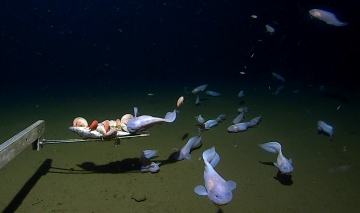Snailfish 04_360 px width_cropped.jpg

The snailfish is the deepest recorded fish species, recently found in the Izu-Ogasawara Trench at a depth of 27,349 feet. Image courtesy of Caladan Oceanic.
As you go further and further into the ocean’s depths, you pass through different zones named for the increasing darkness, from the sunlight zone to the twilight zone, to the midnight zone, to the abyssal zone, to the absolute deepest points in the oceans—the hadal zone. The hadal zone is named for Hades, the Greek god of the underworld, and it stretches from 20,000 feet to as deep as 36,000 feet—nearly 7 miles—below the surface, at the bottom of the deepest trenches.
In complete darkness, with temperatures barely above freezing, the pressure is more than 800 times greater than at the surface. It would seem impossible that any creature could survive. But life finds a way, and scientists have recently filmed a fish swimming at the greatest depth ever recorded: 27,349 feet, or 5.2 miles deep. A juvenile snailfish that was investigating a baited camera in the Izu-Ogasawara Trench off the coast of Japan has now earned itself a place in the Guinness Book of World Records. For a sense of scale, imagine flipping Mount Everest upside down in the ocean. This small, colorless fish would have been swimming just 1,680 feet shallower than Everest’s inverted summit.
How do deep-sea snailfish survive such hostile conditions? They have jelly-like skin instead of scales, fewer bones, and pressure-resistant chemicals that keep their proteins from being crushed. Though they resemble oversized tadpoles that grow to just over 11 inches long, don’t let their innocent looks deceive you. Snailfish are top predators in the hadal zone, subsisting on tiny crustaceans. And although this record discovery has thrilled scientists, data from approximately 500 deep sea cameras across the world suggests this is probably around the deepest we can ever expect to find a fish.


